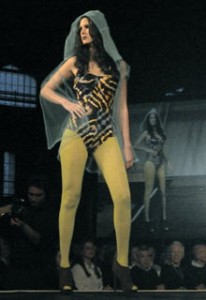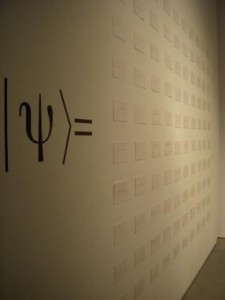Textiles that harvest our energy to recharge the batteries for phones and other portable devices (for example, US Army research in my May 9, 2012 posting and British soldiers prepare to conduct field tests in my April 5, 2012 posting), that protect us from poison gases (my page on nanotechnology and textiles on the Nanotech Mysteries wiki), that clean pollution from the air (my Feb. 24, 2012 posting about Catalytic Clothing), and more are currently being developed. It seems textiles used for passive protection and decoration and other forms of personal enhancement (body shapers, ‘lifts and separates’) are becoming more active. One of the latest developments is a textile that protects from malaria. From the May 8, 2012 news item on Nanowerk,
A Cornell University scientist and designer from Africa have together created a fashionable hooded bodysuit embedded at the molecular level with insecticides for warding off mosquitoes infected with malaria, a disease estimated to kill 655,000 people annually on the continent.
Though insecticide-treated nets are commonly used to drive away mosquitoes from African homes, the Cornell prototype garment can be worn throughout the day to provide extra protection and does not dissipate easily like skin-based repellants. By binding repellant and fabric at the nanolevel using metal organic framework molecules – which are clustered crystalline compounds – the mesh fabric can be loaded with up to three times more insecticide than normal fibrous nets, which usually wear off after about six months.
“The bond on our fabric is very difficult to break,” said Frederick Ochanda, postdoctoral associate in fiber science and apparel design (FSAD) in the College of Human Ecology and a native of Kenya. “The nets in use now are dipped in a solution and not bonded in this way, so their effectiveness doesn’t last very long.”
I’m assuming that this design will be reworked to accommodate more average bodies (from Cornell University’s ChronicleOnline April 30, 2012 article by Ted Boscia,

Sandy Mattei models a design by Matilda Ceesay '13, an FSAD apparel design major from Gambia, at the Cornell Fashion Collective spring fashion show April 28 on campus. Credit: Mark David Vorreuter
Boscia gives details,
The colorful garment, fashioned by Matilda Ceesay ’13, an FSAD apparel design major from Gambia, debuted at the Cornell Fashion Collective spring fashion show April 28 [2012] on campus. It consists of an underlying one-piece bodysuit, hand-dyed in purple, gold and blue, and a mesh hood and cape containing the repellant. The outfit is one of six in Ceesay’s collection, which she said “explores and modernizes traditional African silhouettes and textiles by embracing the strength and sexuality of the modern woman.”
Ceesay and Ochanda, who works with FSAD Associate Professor Juan Hinestroza, partnered with Laurie Lange, graduate student in Professor Kay Obendorf’s lab, to refine the process for capturing insecticides on the MOF-coated cloth. Hinestroza called the resulting garment “fashionable and functional, with the potential to create a new generation of durable and effective insecticide mosquito protection nets.”
The researchers are not pinning all of their hopes on the body suit (from Boscia’s April 30, 2012 article),
Ultimately, Ceesay and Ochanda hope the outfit they developed will serve as a prototype to drive new technologies for fighting the spread of malaria. On the horizon, Ochanda said, is an MOF fabric that releases repellant in response to changes in temperature or light — offering wearers more protection at night when mosquitoes are on the hunt. At minimum, they hope the technology can be applied to create longer lasting insecticide-laden bed nets.
Despite the use of mosquito nets, “people are still getting sick and dying,” Ceesay said. “We can’t get complacent. I hope my design can show what is possible when you bring together fashion and science and will inspire others to keep improving the technology. If a student at Cornell can do this, imagine how far it could go.”
Both the designer and scientist have a very personal stake in creating textiles that will repel malaria-borne mosquitoes (from Boscia’s article),
Ochanda and Ceesay, from opposite sides of the continent, both have seen family members suffer from the disease. Its prevalence in Africa — the source of 90 percent of the world’s malaria infections annually — can also lead to harmful misdiagnoses. Ceesay recalls a family member who died after doctors treated her for malaria when she had a different sickness. “It’s so common back home; you can’t escape it,” Ceesay said.
“Seeing malaria’s effect on people in Kenya, it’s very important for me to apply fiber science to help this problem,” Ochanda added. “A long-term goal of science is to be able to come up with solutions to help protect human health and life, so this project is very fulfilling for me.”
There’s no mention of how close this textile is to becoming a product and being offered in the marketplace. So, for anyone who’s generally interested in nanotechnology-enable textiles and possible economic impacts and business outlooks, Cientifica released its report, Nanotechnologies for Textile Markets in April 2012 (available for purchase). From the April 16, 2 012 news release and report description webpage,
While the traditional markets of apparel and home textiles continue to be impacted by nanotechnologies, especially in adding value through finishing and coating, the major opportunities for both textile manufacturers and nanomaterial suppliers lie elsewhere.
“Nanotechnologies for the Textile Market” takes an in depth look at the major textile markets – apparel, home, military, medical, sports, technical and smart textiles – detailing the key applications of nanotechnologies and the major players. The 255 page report contains full market analyses and predictions for each sector to 2022, outlines the key opportunities and is illustrated with 98 figures and 30 tables.
Cientifica predicts that the highest growth over the next decade will be seen in the areas of smart and technical textiles. In both of these areas a significant part of the added value is due to the innovative use of nanotechnologies, whether in fiber production or as a coating or additive.
With over a billion Bluetooth enabled devices on the market, ranging from smartphones to set top boxes, and new technologies such as energy scavenging or piezoelectric energy generation being made possible by the use of nanotechnologies , there are opportunities for the textile industry in new markets ranging from consumer electronics to medical diagnostics.
‘It’s a perfect storm” added Tim Harper [Cientifica’s Chief Executive Office], “the availability of new materials such as graphene, the huge leaps being made in organic electronics, and the move towards the Internet of Things is blurring the divide between textiles and electronic devices. When two trillion dollar markets collide there will be lots of disruption and plenty of opportunities.”
Cientifica does offer a free download of the report’s Table of Contents (ToC). Here’s a sample from the ToC which gives you a preview of the report’s contents,
EXECUTIVE SUMMARY 11
INTRODUCTION 21
Objectives of the Report 21
World Textiles and Clothing 22
Overview of Nanotechnology Applications in the EU Textile Industry 24
Overview of Nanotechnology Applications in the US Textile Industry 25
Overview of Nanotechnology Applications in the Chinese Textile Industry 26
Overview of Nanotechnology Applications in the Indian Textile Industry 27
Overview of Nanotechnology Applications in the Japanese Textile Industry 27
Overview of Nanotechnology Applications in the Korean Textile Industry 29
Textiles in the Rest of the World 31
Macro and Micro Value Chain of Textiles Industry 32
Common Textiles Industry Classification 32
End Markets and Value Chain Actors 32
Why Textiles Go Nano 34
Nanotechnology in Textiles 34
Nanotechnology in Some Textile-related Categories 37
Technical & Smart Textiles 37
Multifunctional Textiles 39
High Performance Textiles 39
Smart/Intelligent Textiles 39
Nanotechnology Hype 41
CURRENT APPLICATIONS OF NANOTECHNOLOGY IN TEXTILE PRODUCTION 43
Nanotechnology in Fibers and Yarns 43
Nanotechnology in Fabrics 47
Nanotechnology in Textile Finishing, Dyeing and Coating 55
Nanotechnology In Textile Printing 66
Green Technology — Nanotechnology In Textile Production Energy Saving 67
Electronic Textiles 67
Concept 67
Markets and Impacts 68
Current E-Textile Solutions and Problems 69
Nanotechnology in Electronic Textiles 78
Future and Challenges of Electronic Textiles 87
NANOTECHNOLOGY APPLICATIONS IN CLOTHING/APPAREL TEXTILES 89
Summary of Nanotechnology Applications in Clothing/Apparel Textiles 90
Current Applications of Nanotechnology in Clothing/Apparel Textiles 91
Hassle-free Clothing: Stain/Oil/Water Repellence, Anti-Static, Anti-Wrinkle 91
The Guardian newspaper in an October 4, 2011 article by Colin Stuart offers a brief , comprehensive but cautionary overview of nanotechnology-enabled textiles (thanks for the tip, Tim Harper),
The manipulation of textiles is an age-old practice, starting with the furs of the animals we hunted. As agriculture and farming grew, we began to weave natural fibres, providing us with fabrics such as cotton and wool – sartorial staples we’ve relied on for centuries.
…
Unsurprisingly, the most mainstream use of nanotextiles is in clothing. The chances are you have some nanotextiles hanging in your wardrobe; wrinkle-free or non-iron garments have been engineered against creasing by coating the fibres with nanoparticles. Nanotechnology is also responsible for the stain-resistant fabrics found in both clothing and carpets. Tiny, nano-sized hairs are added to the surface of the material which stop liquids from being absorbed. …
The nano clothing of the future, however, could add even more functionality to the latest fashions. Tomorrow’s must-wear materials could hide piezoelectrics – nanotechnology that harvests the energy created as you rub against the fabric. Imagine walking along as your every move helps charge an iPod strapped to your belt.
But nanotextiles are not just confined to clothing; they are also being used in Asia in the battle against malaria. In 2010 a group of Thai researchers announced they had created mosquito nets laced with nanoparticles of pyrethroid, an insecticide. Pyrethroid had been combined with nets before, but doing so on the nanoscale means the particles are small enough to cling to the fibres even when washed. These nano-nets can last up to five years – a five-fold improvement on conventional netting.
The article goes on to establish concerns over environmental, health, and safety regulations but I thought it best to end with the mosquito nets and malaria, which is where this posting started, more or less.



